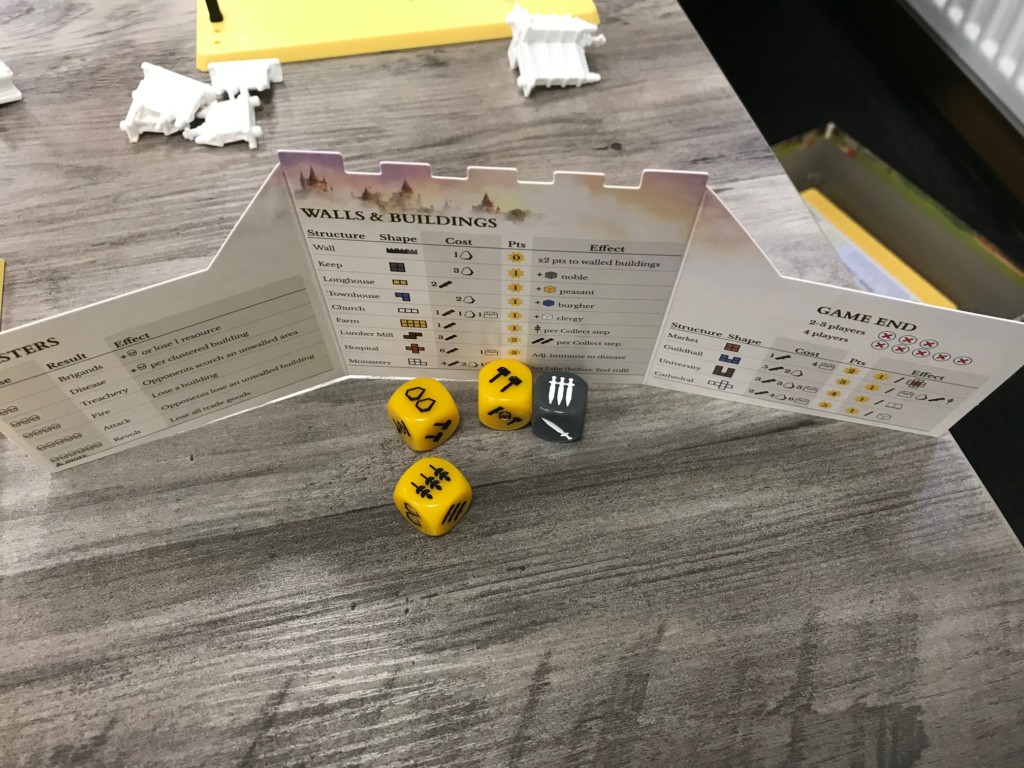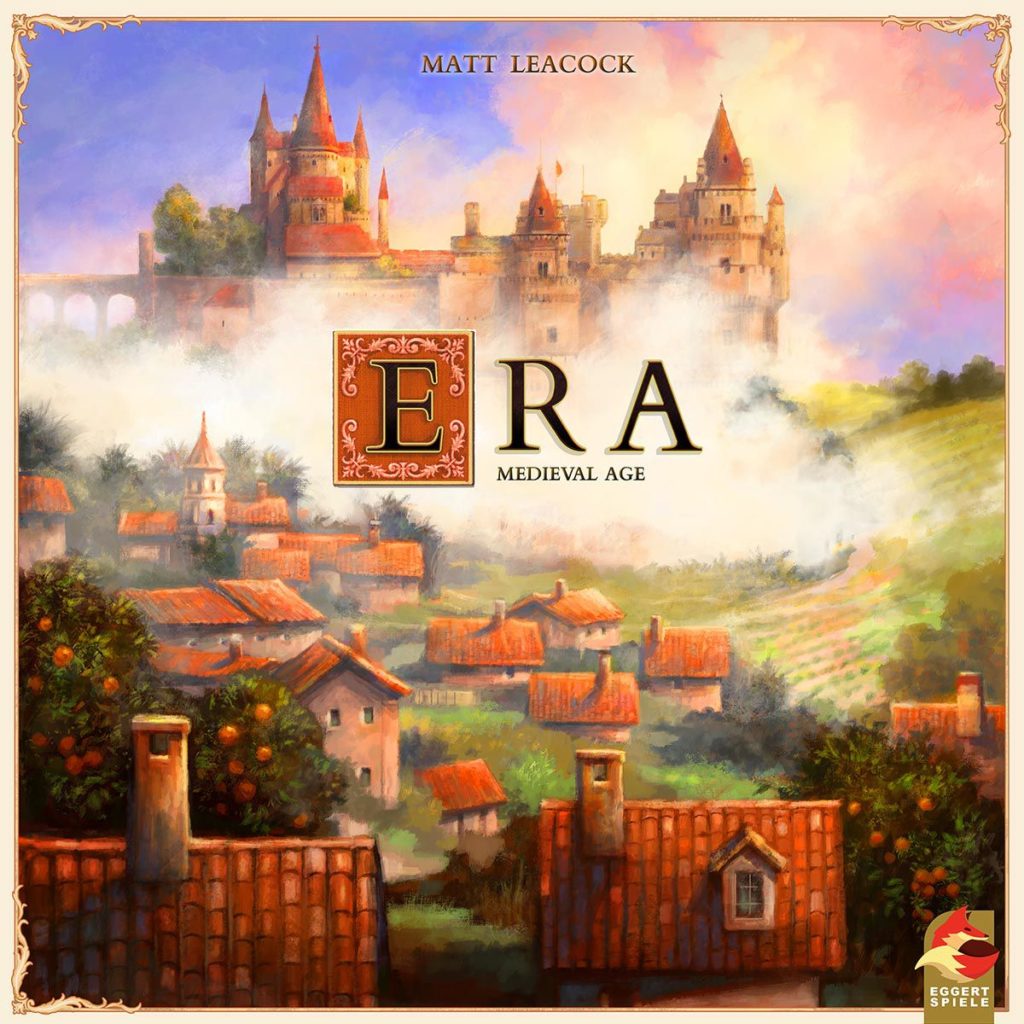In Era: Medieval Age you’ll build your ‘plug n play’ Medieval town.
Time to play with some toys…
In Era, your dice represent different classes of medieval society as players attempt to build the most prosperous city.
Era: Medieval Age Game Play
Note: This is a brief overview, far from comprehensive but has all the important stuff, promise!
Each player has a bright yellow pegboard with holes in with a square ‘Keep’ building piece right in the middle. They then get 3 Longhouses, 3 Walls and a Farm that they put where they like.
They also get a number of ‘Scorched Areas’ depending on the player count to fill that board up with useless nonsense for games with fewer players.

The start player gets a little black peg they use to track the 6 steps in a round of play. Here they are!
1 – Roll all of your Dice
The dice in your dice pool is based on the buildings in your little pegboard town. Different building types of different colours give you dice of those colours into your pool.
These dice give you Resources and Culture as well as allowing you to Build and other bits and bobs.
Players have 3 rerolls but dice showing a Skull can’t be rerolled. Dice are rolled, rerolled and stored behind a player screen, then revealed simultaneously.

2 – Collect Resources
Gain the amount of Trade Goods, Stone, Wood, Food and Culture shown on your dice results. These are tracked with pegs on your bright yellow pegboard thing.
Then, add 1 Food per Farm in your Town, remember you start with one. You also gain resources from other buildings, such as Wood from Lumber Mills. More on how you get those in a bit.
3 – Feed your Population
Spend 1 Food per Die in your dice pool. For each ‘Die’ you can’t feed, add 1 to your Disaster track.
4 – Resolve Disasters
In turn order, players resolve their own personal Disaster for that round depending on the number of Skulls they have in their rolled dice pool.
There are 6 possible:
- 1 – Brigands – Gain a Skull or Lose 1 Resource
- 2 – Disease – Gain a Skull per Clustered (Orthogonally Adjacent) building
- 3 – Treachery – Opponent gains a Scorched Land
- 4 – Fire – Lose a Building
- 5 – Attack – Opponent loses an unwalled building
- 6+ – Revolt – Lose all trade goods
5 – Build
Finally, we can talk about getting more stuff on that pegboard. Here you spend your gained resources to get more Buildings onto your board. In turn order, players build one building each until everyone is done. You can build one building per Hammer icon rolled on your dice.
There is a limited supply (reduced by the player count) on some buildings so it needs to be done in order. Also, when a building type runs out you flip over a token and when all tokens are flipped this will end the game.
Back to it, the cost of the building and its effect is shown on the back of the player screen. Reduce the cost of each material on your player board for each building you build using the tracking pegs.

The piece can fit anywhere on your board in any orientation. It’s important to note for disasters, scoring and stuff that is only orthogonally adjacent is only adjacent in this game, diagonal doesn’t count.
Walls, as you can imagine, are used to Wall in buildings. Buildings surrounded by a contiguous section of Walls and/or Keeps count as being ‘Walled’.
Most buildings give you more dice to your pool or resources each round. But some have effects like the Hospital that prevent the spread of Disease to adjacent buildings.
6 – Extort
This is where the Swords on the dice you rolled come into play. In turn order, players can steal a resource from each player with fewer Swords.
If a player can’t (or won’t) pay they move their Disaster peg up two times each time a resource can’t be (isn’t) paid. Of course, you can protect yourself by having enough Shields to fend off all the Swords so you don’t have to pay a thing.
Round End
Players check to make sure they have the right number and colour of dice matching their buildings. The start player ‘peg’ passes left. If all those Building markers were flipped face down, the game ends otherwise players go back to rolling dice.
Game End
Players score for:
- Value of Buildings as shown on the player screen (Doubled if ‘Walled’)
- Bonus points from Buildings (Guildhall gives 1 point per resource)
- 1 point per Culture
- 5 points to the player/s with the most Culture
- 10 points to the player/s with the largest walled area (Counting spaces inside the Walled Area)
- -1 point for each space on the Disaster track
The player with the most points wins.
Theme
Urgh, Medieval stuff again. It makes sense and things with what you do and how it rewards you but still…
I would like to see this style of game with a more interesting theme.
That name.. ‘Medieval Age’… More ages coming? Or is it just that ‘Era’ would be too bland along? Era: Cold War anyone?
Setup
This is fine… You have to put aside a number of buildings of different types you’re not using for the player count so it’s a little thing you need to lookup.
You also have to roll off for the start player… Not my favourite way of doing things but random is random I guess 🙂
Components & Artwork
Obviously, the buildings look good and plugging them into that pegboard is a nice touch. Still, can’t help thinking that tiles wouldn’t work just as well and bring the cost of the game down? Although, tiles work better when pushed together orthogonally so they stay in place so maybe not?

Now, yellow symbols on a YELLOW BACKGROUND! WHY!? What an absolutely major error!
No art really to speak of… The box art does the game a disservice I think.
Ease of Teaching & Accessibility
It seems easy to learn so should be easy to teach. If you can explain the buildings and scoring you’re golden…
It is quite accessible. Rolling the dice is in secret so players will need to be aware of what they need so they know what to keep and re-roll.
Era: Medieval Age Summary
Era: Medieval Age is just a toy… OK, it’s more than a toy but it really FEELS like you’re playing with a toy.
The game is fine and reminded me of 7 Wonders. Any game where you get stuff to build stuff and then fight your opponents will ALWAYS bring me back to this game.
There are obvious Polyomino comparisons too like Barenpark which has a more fun theme. This is the more even ‘game to game’ comparison too and the game I had in mind when I spoke about Tiles vs Plastic Bits.
Toys, they’re toys.
There is a fair bit of luck with the die rolls unless you focus on getting buildings that allow you to reroll Skulls. Sometimes you get stuck with a bad turn that sees you being able to build a lot with no resources to spend.
You also have to ‘feed your people’ which is a distraction I didn’t need.
I think there is a lot of competition for this style of game that comes in cheaper, more fun packages. Plenty of Roll & Writes for example, but this isn’t too bad I guess.
Jesta ThaRogue


Leave a Reply